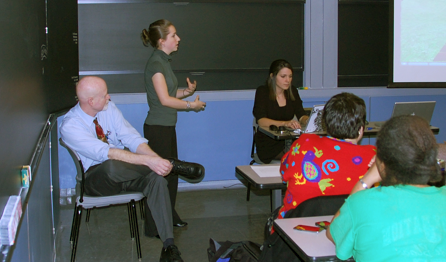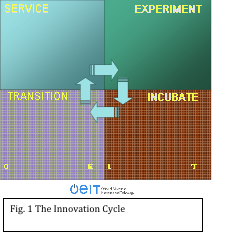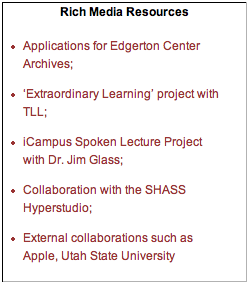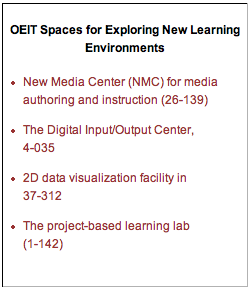Introduction
OEIT Strategy
Technology Strategy
Educational Outreach Strategy
Organizational Strategy
Strategic Opportunities and Engagements
The Office of Educational Innovation and Technology (OEIT) engages with the MIT community to develop, disseminate and advance the sustainability of educational innovations through the strategic use of technology.
OEIT focuses on three key areas to which it brings unique perspective, skills, and methodologies. These are bridging research and learning, linking digital content to the curriculum, and fostering communities of innovation and practice.
 Channeling its energies in these three broad areas, OEIT reifies educational opportunities enabled by technology for the MIT community. This enables educational innovation to shape MIT's effort and readiness for 21st century education. OEIT complements existing DUE offices through engagement in curriculum revision, delivery, innovation outreach and educational infrastructure initiatives.
Channeling its energies in these three broad areas, OEIT reifies educational opportunities enabled by technology for the MIT community. This enables educational innovation to shape MIT's effort and readiness for 21st century education. OEIT complements existing DUE offices through engagement in curriculum revision, delivery, innovation outreach and educational infrastructure initiatives.
Bridging Research and Learning – OEIT tackles one of higher education’s perennial faculty issues: how do we constructively bring the practice of research to the process of learning? OEIT develops and leverages innovative tools and best practices to provide support for bridging research and learning at MIT, a service that is unique at the Institute and elsewhere in higher education.
Linking Content to the Curriculum – It is said that on the internet “Content is King,” but OEIT understands more than any organization that how information is integrated in the process of teaching and learning is as important, if not more so, than the mere existence of content. OEIT provides leadership and coordination of activities that address how digital content is accessed and employed creatively in a wide range of educational innovations.

Fostering Communities of Innovation and Practice – OEIT’s efforts to support adoption and diffusion of educational computing initiatives rely on developing communities of common interest and practice. Towards this end OEIT fosters, catalyzes and supports communities around specific technology solutions, such as visualization, pedagogies, such as active learning, and specific educational innovations, such as iLabs.
[ top ]
OEIT’s technology strategy is directed toward exploring contemporary technology applications to education with a view to informing the MIT community on their promise and implementation considerations. OEIT identifies, develops, acquires and delivers innovative educational technology with a focus on increasing sustainability and capacity.
[ top ]
OEIT aims to facilitate awareness, deep understanding and transference of educational innovations at MIT and elsewhere. We intend our educational outreach efforts to go beyond being "a showcase" to being a vehicle for sharing and dissemination of innovative teaching and learning practices, leading to contextually relevant adoption and eventually to successful educational transformation. Toward this end we want to enable the development of communities of interest and practice around pedagogies and educational technology, using web technology, powerful multimedia, knowledge management, as well as social and semantic networking technologies for finding and utilizing appropriate educational resources and encouraging knowledge sharing.

[ top ]
OEIT staff collaborates with faculty, students and administrative staff to identify, develop and distribute innovative uses of educational technology at MIT. With strategic guidance from the MIT Council on Educational Technology and through close linkages with DUE’s Teaching and Learning Lab (TLL), the Office of Faculty Support (OFS) and the Office of Experiential Learning, OEIT communicates the availability of new educational innovations to faculty and students, and facilitates the adaptation and adoption of innovations to help improve teaching and learning at MIT. Finally, OEIT collaborates and provides leadership through the Academic Computing Coordination Group (ACCORD) with DUE’s mission partners, notably Information Services and Technology (IS&T) and the MIT Libraries, to ensure that innovative technology applications are supported as sustainable services and that faculty at the Institute are able to avail themselves of these services in a seamless way.
OEIT’s specific activities are directed towards amplifying and extending MIT education through integrating digital technology and online resources:
Guiding our activities as an Innovation Cycle (Fig.1), which charts the passage of innovation through the following stages:
 Experiment: conception and early experimentation, typically by faculty in the departments, labs and centers but also in other academic and industrial settings. OEIT’ s engagement at this stage is to help identify educational possibilities and more sharply define the educational need.
Experiment: conception and early experimentation, typically by faculty in the departments, labs and centers but also in other academic and industrial settings. OEIT’ s engagement at this stage is to help identify educational possibilities and more sharply define the educational need.
[ top ]
OEIT strategy is based on investigating new educational technologies, bridging departments who share common uses of educational tools and approaches, implementing test beds to try out new approaches to teaching with technology, and facilitating the identification of transition plans to support those technologies that have demonstrable value so that they are delivered reliably and efficiently by the appropriate service unit on campus. The key opportunities that we see are:

1. Research tools for learning – OEIT is working to transform research tools that faculty and researchers use daily, into applications that support learning, thus providing early exposure to the research process and presenting a tangible approach to bridging faculty research and student learning.

2. Leveraging rich media resources – Transmedia Services and Applications (TSA) that are meaningful to the curriculum through content authoring and end-user applications.

3. Interactive learning environments for the future – designing, developing and implementing – OEIT is helping MIT explore intelligent combinations of situated, cyberspace, formal and non-formal environments to support innovative practices and blended learning. This includes preserving the value of learning on campus while extending interactions and partnerships globally; integrating remote laboratories (iLabs) into undergraduate courses, redesigning computing labs to meet current and future student learning requirements; Project-based Learning (as learning experiences and communities.
4. Digital Literacy – Through expanding the New Media Center and extending engagement with faculty working in digital scholarship, OEIT seeks to provide the infrastructure, tools and expertise for the digital literacy that will be required for informed citizenship, and leadership in the 21st century.
5. Develop rich-media integrated Web environments to showcase MIT educational innovation efforts and serve as interactive space for discovery and learning of innovative practice and resources for communities of interest across MIT (e.g., in areas such as visualization, collaboration, active learning, etc).
6. Fostering communities to disseminate innovations through MIT events such as Crosstalk, and through participation in national/international forums and discourse in educational technology.
7. Student engagement in educational innovation – OEIT engages and supports student initiative in employing technology for innovative educational applications. Through developing a student technology education innovation program rich linkages can be built to the Experimental Learning program, global education programs as well as school and departmental initiatives. Launching The MRiTIS (Microsoft Research iCampus Technology Innovation Student Prize.), hosting and supporting OLW as well as “This American Summer” are steps that OEIT has taken in this regard.
8. Develop new organizational alignments for innovation partnerships. OEIT’s unique orientation as an R&D organization for education and its strong foundation of international leadership in educational technology brings new technology opportunities as well as for developing sustainable solutions. Some of these potential partnerships build on the strong foundation of international leadership in educational innovation and technology of MIT initiatives like OCW, iCampus and O.K.I and involve industry (for example Apple Computer, Microsoft Research) as well as academic collaborations. Internal opportunities include organizational linkages with the Center for Educational Computing Initiatives and HyperStudio in SHASS.

9. Resource development – pursue opportunities for external support where it aligns closely with an MIT & OEIT initiatives, including partnering with funded faculty. In June 2008, for example, the STAR team partnered with the biology department and received a significant grant from the Davis Educational Foundation, for Bringing Biology Research Software into the Classroom.
Looking over the horizon, OEIT engages in exploratory activities to identify technology-based solutions for new modes of collaboration, production, delivery and sustainability of educational resources and experiences. Examples of this include: ePortfolios - applied to the Student Vision project, minority education (OME), the Gordon Leadership Initiative, advising (UAAP), student career preparation and others; Alternative Paradigms for HCI - educational opportunities of emerging technologies in areas such as pen-based computing for active/collaborative learning; making repositories of multi-media content accessible to a wider range of users and tools; and transcribing digital media for more effective just-in-time learning.
[ top ]